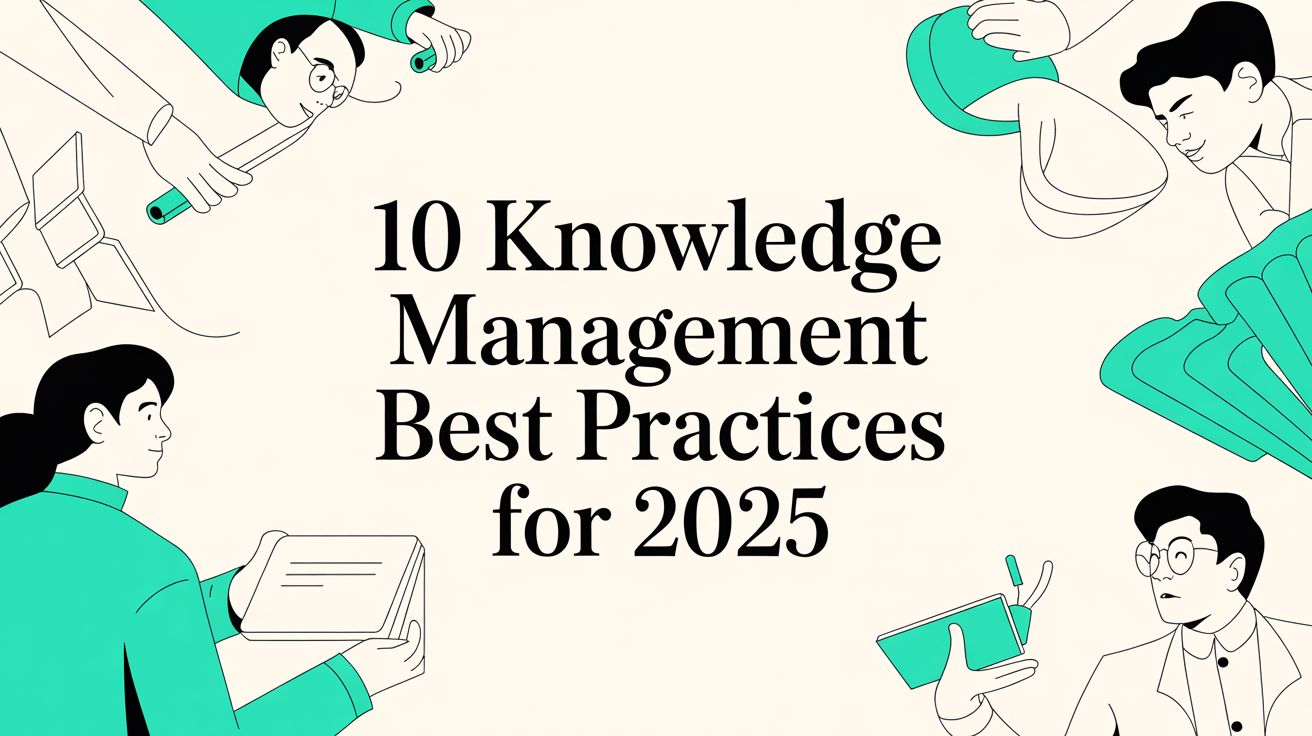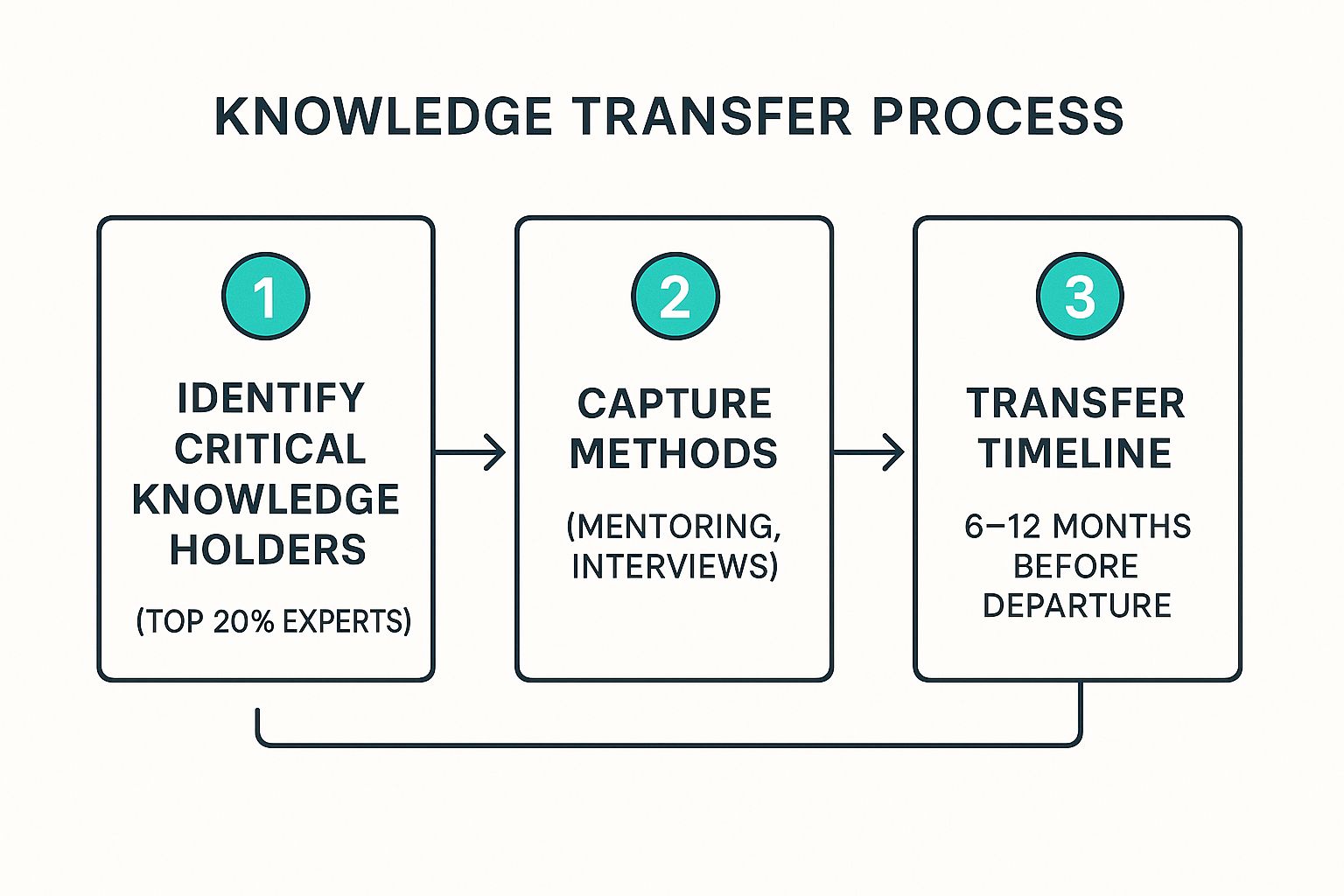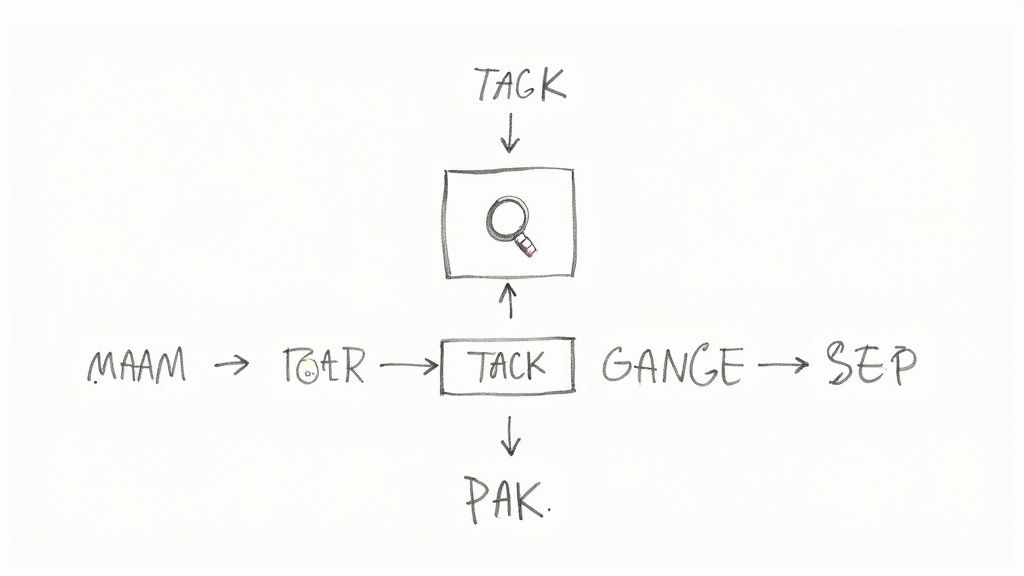10 Knowledge Management Best Practices for 2025

In today's fast-paced business environment, your organization's most valuable asset is not on the balance sheet. It is the collective expertise, experience, and insights held by your team. This 'institutional knowledge' is the key to innovation, efficiency, and a sustainable competitive advantage. However, without a deliberate strategy, this critical asset can be lost, siloed, or underutilized, leading to repeated mistakes and squandered opportunities.
Effective knowledge management transforms this hidden genius into a powerful, accessible resource that fuels growth and resilience. By implementing a structured approach, you can ensure that valuable information is captured, shared, and applied consistently across your entire organization. This is where a clear set of knowledge management best practices becomes essential.
This guide moves beyond theory to provide a practical roadmap. We will explore 10 actionable strategies designed to help you build a smarter, more connected organization. From fostering a culture of collaborative sharing to leveraging technology for intelligent knowledge discovery, each practice is a critical component in a comprehensive system. You will learn how to capture, organize, and activate the institutional knowledge that truly drives success, ensuring your team's collective intelligence becomes your greatest strength.
1. Create a Knowledge-Sharing Culture
Effective knowledge management isn't just about tools and processes; it's fundamentally about people. A knowledge-sharing culture is an organizational environment where employees are actively encouraged, rewarded, and empowered to share their expertise, insights, and lessons learned. This cultural foundation is one of the most crucial knowledge management best practices, shifting the default from hoarding information to collaborative growth and collective intelligence.

This approach moves beyond simply capturing data and focuses on creating a safe, transparent space for dialogue. For instance, Toyota’s "kaizen" philosophy empowers every worker to share process improvements, while Pixar's "Braintrust" meetings facilitate radically candid feedback to elevate creative projects. The goal is to make sharing knowledge a natural, integrated part of daily work, not an additional task.
How to Implement a Knowledge-Sharing Culture
To build this culture, leadership must champion the change. Start by visibly participating in knowledge-sharing activities and celebrating employees who contribute.
- Integrate and Incentivize: Make knowledge sharing a formal part of job descriptions and performance reviews. This sends a clear message that contributing to the collective knowledge base is valued.
- Remove Barriers: Simplify the process. If sharing information requires navigating a clunky system or takes too much time, employees won't do it. Use intuitive tools and dedicate specific time for these activities, such as "learning hours" or show-and-tell sessions.
- Promote Success Stories: Publicly recognize individuals and teams who exemplify a collaborative spirit. Share how their contributions solved a problem, improved a process, or helped a colleague, reinforcing the positive impact of their actions.
2. Implement a Centralized Knowledge Repository
A centralized knowledge repository is a unified, searchable platform where organizational knowledge, documents, procedures, and expertise are stored and organized systematically. This single source of truth is a cornerstone of effective knowledge management best practices, ensuring employees find accurate information without hunting through siloed systems like emails, shared drives, and chat logs. It transforms scattered data into accessible, collective intelligence.
This approach creates one official place for mission-critical information. For example, Atlassian’s Confluence allows teams at Spotify and LinkedIn to build project hubs and document processes, while NASA’s Lessons Learned Information System (LLIS) captures decades of engineering insights to prevent repeating past mistakes. The goal is to reduce redundant work and accelerate problem-solving by making answers findable.
How to Implement a Centralized Knowledge Repository
Success hinges on a deliberate strategy for organization and upkeep, not just the technology itself. Start by defining what knowledge is most critical to capture and who will benefit from it.
- Establish a Clear Structure: Begin with a well-defined taxonomy and information architecture. A logical folder structure, consistent tagging system, and clear naming conventions prevent the repository from becoming a digital junk drawer.
- Assign Content Owners: Designate subject matter experts responsible for creating, reviewing, and updating content in their specific domains. This ensures information remains accurate, relevant, and trustworthy over time.
- Integrate and Simplify Access: Embed search functionality into daily workflows and tools like Slack or Microsoft Teams. If employees can access the repository without leaving their primary applications, adoption rates will skyrocket. Ensure the platform is mobile-friendly for easy access anywhere.
3. Capture Tacit Knowledge Through Documentation and Storytelling
Tacit knowledge, the "know-how" and intuition that exists only in people's minds, is often an organization's most valuable yet vulnerable asset. Unlike explicit knowledge, which is easily written down, this expertise is difficult to articulate. This knowledge management best practice involves systematically converting this unspoken wisdom into explicit, shareable formats through methods like interviews, storytelling, and mentoring.

The goal is to preserve critical expertise before it walks out the door when an employee retires or leaves. The U.S. Army's After Action Review (AAR) process, for instance, systematically captures lessons from every mission, converting experience into actionable intelligence. Similarly, NASA’s oral history project documented irreplaceable insights from the Apollo program, ensuring that the intuitive knowledge of its engineers was not lost to time.
How to Capture Tacit Knowledge
Start by identifying the most critical knowledge and the experts who hold it, particularly those nearing retirement or in unique roles. Make knowledge transfer a formal part of succession planning.
- Use Storytelling and Scenarios: Instead of asking "what do you know," ask experts to tell "war stories" about how they solved a tough problem. This narrative approach uncovers the context, decision-making processes, and nuanced thinking that simple documentation misses.
- Implement Mentorship and Pairing: The apprenticeship model is one of the oldest and most effective methods. Pair senior experts with junior employees, allowing tacit knowledge to be transferred organically through observation, practice, and shared experience.
- Leverage Video and Recordings: For complex or physical processes, video is invaluable. Record experts as they perform a task or explain their thought process in a "show-and-tell" format. This captures subtleties that are impossible to write down.
4. Leverage Technology and AI for Knowledge Discovery
Modern knowledge management best practices increasingly rely on technology to do the heavy lifting. Leveraging artificial intelligence (AI), machine learning, and advanced analytics helps employees discover relevant information, surface insights from vast datasets, and connect with experts more efficiently. These technologies can automate knowledge capture, improve search relevance, and proactively deliver knowledge where it's needed most, transforming passive repositories into intelligent assistants.
This approach goes beyond a simple search bar. For example, JPMorgan's COiN platform uses machine learning to analyze legal documents, saving thousands of hours of manual work. Similarly, Microsoft Viva Topics automatically organizes company-wide content into topic pages, making expertise easily discoverable. The goal is to embed intelligent knowledge discovery directly into daily workflows, reducing friction and accelerating problem-solving.
How to Implement Technology and AI
To successfully integrate AI, start with a clear problem to solve rather than adopting technology for its own sake. Begin with high-impact, narrow use cases before expanding across the organization.
- Ensure Data Quality: AI is only as good as the data it learns from. Before implementation, establish strong data governance and ensure your knowledge base is clean, organized, and up-to-date.
- Integrate with Existing Workflows: Choose platforms that integrate seamlessly with the tools your team already uses, like Slack, Microsoft Teams, or your CRM. Tools like Guru and Coveo excel at delivering verified knowledge within existing workflows.
- Combine AI with Human Curation: Use AI for initial discovery and organization, but empower subject matter experts to review, verify, and refine the AI's output. This human-in-the-loop approach ensures accuracy and builds trust in the system.
5. Establish Communities of Practice
One of the most effective knowledge management best practices is to cultivate Communities of Practice (CoPs). These are groups of people who share a passion or a profession and learn how to do it better as they interact regularly. Unlike formal project teams, CoPs are often self-organizing networks that bring together experts across different departments, hierarchies, and even geographic locations to share insights, solve common problems, and innovate.
This approach creates a powerful, living repository of expertise. For example, Xerox’s community of service technicians famously shared repair tips through an informal network, saving the company millions in service costs. Similarly, the World Bank’s Thematic Groups connect development experts globally, allowing them to share best practices on everything from infrastructure to public health. The goal is to nurture these organic networks where deep, practical knowledge is created and circulated.
How to Implement Communities of Practice
To successfully establish CoPs, provide sponsorship and support without over-managing them, allowing the community's passion and purpose to drive engagement.
- Empower Champions and Provide Resources: Identify enthusiastic individuals to lead and build initial momentum. Provide them with the necessary tools, such as a dedicated communication channel (like a Slack channel or forum) and a small budget for activities.
- Connect to Business Outcomes: While CoPs are often informal, ensure their efforts align with strategic business challenges. Frame discussions around solving real-world problems to demonstrate their value and maintain organizational support.
- Balance Structure and Informality: Create opportunities for both structured events, like expert presentations or problem-solving workshops, and informal networking. This allows members to build relationships and share knowledge in a way that feels natural and unforced.
6. Implement Systematic Knowledge Retention Programs
Valuable organizational knowledge is often concentrated in a few key experts, making their departure a significant risk. Systematic knowledge retention programs are structured initiatives designed to identify, capture, and preserve this critical expertise before it is lost due to retirement, turnover, or other organizational changes. This is one of the most proactive knowledge management best practices, ensuring business continuity and safeguarding decades of institutional wisdom.
This approach goes beyond a simple exit interview. It involves a long-term strategy for transferring both explicit and tacit knowledge from seasoned employees to their successors. For example, NASA's comprehensive knowledge management program was intensified after the Columbia disaster to prevent the loss of critical engineering insights, while the Tennessee Valley Authority uses a similar model to transfer complex operational knowledge from retiring nuclear engineers to the next generation.
The following infographic outlines a simple, effective process for retaining critical knowledge.

This streamlined workflow emphasizes that successful knowledge transfer is a planned process, not a last-minute activity.
How to Implement a Knowledge Retention Program
A successful program requires early identification of at-risk knowledge and a multi-faceted transfer plan. Start by pinpointing the top 10-20% of employees whose departure would cause the most significant disruption.
- Create Role-Specific Transfer Plans: Don't use a one-size-fits-all approach. For each critical role, outline the specific knowledge that needs to be captured and select the best methods, such as mentorship, job shadowing, detailed documentation, or phased retirement arrangements.
- Start the Process Early: Begin knowledge transfer activities at least 6 to 12 months before a planned departure. This provides ample time for comprehensive shadowing, Q&A sessions, and documenting not just what decisions were made, but why.
- Build Redundancy: Avoid transferring critical knowledge to only one person. Cross-train multiple team members on essential skills and processes to create a resilient and adaptable workforce that can absorb the impact of any single departure.
7. Integrate Knowledge Management into Workflows
The most effective knowledge management systems are invisible. Instead of asking employees to step out of their daily tasks to find or store information, this best practice embeds knowledge capture, sharing, and reuse directly into existing workflows. This "knowledge in the flow of work" approach makes contributing and accessing information a natural, seamless part of getting things done, dramatically increasing adoption and impact.

This method reduces the friction that often prevents employees from using a knowledge base. For example, a Salesforce integration can automatically surface relevant solution articles for a customer service agent while they are actively working on a ticket. Similarly, a tool like Guru can deliver verified information directly within a Slack conversation, eliminating the need to switch apps and search for an answer. The goal is to deliver knowledge at the precise moment of need.
How to Integrate Knowledge Management into Workflows
Start by identifying high-frequency tasks where timely information is critical. Map out the existing process and pinpoint opportunities to embed knowledge prompts and access points.
- Leverage Smart Integrations: Use tools that bring your knowledge base into the applications your teams use every day, like Microsoft Teams, Slack, or your CRM. Microsoft Viva Topics, for instance, automatically displays knowledge cards when specific terms are mentioned in conversations.
- Automate Knowledge Capture: Configure your systems to create knowledge from completed work. ServiceNow can auto-generate a knowledge article from a resolved IT ticket, capturing the solution with minimal manual effort and making it available for future incidents.
- Make it Simple and Rewarding: Ensure contributing is as easy as a single click or filling out a simple template. Provide immediate value to users by surfacing relevant information that helps them do their job faster, which inherently encourages participation.
8. Measure and Demonstrate Knowledge Management Value
To secure long-term investment and drive continuous improvement, knowledge management must prove its worth. Measuring its value involves connecting initiatives directly to tangible business outcomes, moving beyond simple usage statistics. This is one of the most critical knowledge management best practices because it translates abstract benefits like "improved collaboration" into concrete metrics like "reduced project timelines" that leadership understands and supports.
This approach makes the impact of shared knowledge visible and undeniable. For example, Siemens reported that its knowledge-sharing network, ShareNet, led to a 20% faster problem resolution time. Similarly, Texas Instruments measured a 50% reduction in product development cycles by effectively reusing existing knowledge. The goal is to build a business case for knowledge management by linking it to efficiency, innovation, and profitability.
How to Measure and Demonstrate Value
Start by establishing baseline metrics before you implement new KM initiatives to accurately track progress. Focus on outcomes, not just activity.
- Align Metrics with Business Goals: Connect your measurements to strategic objectives. If the company goal is to accelerate innovation, track metrics like a reduction in product development time or an increase in patent submissions.
- Use a Balanced Scorecard: Combine quantitative data (e.g., time saved, support ticket reduction) with qualitative feedback (e.g., employee satisfaction surveys, testimonials). A story about how finding an old project proposal saved a team two weeks of work can be as powerful as a chart.
- Communicate Success Regularly: Don't wait for annual reviews to share results. Create dashboards and regular reports that showcase key metrics and success stories. Frame the data in terms of ROI, cost savings, and competitive advantage to resonate with executive stakeholders.
9. Implement Robust Knowledge Governance and Quality Control
A knowledge base without quality control quickly becomes a digital junkyard: cluttered, untrustworthy, and ultimately useless. Knowledge governance establishes the policies, roles, and standards that ensure your organization’s knowledge assets remain accurate, relevant, and secure. This is one of the most critical knowledge management best practices for building long-term trust and usability in your systems.
Effective governance prevents information decay by creating clear rules for the entire content lifecycle, from creation to archiving. For example, pharmaceutical companies use stringent governance to meet FDA compliance, while Wikipedia’s editor hierarchy and review processes ensure encyclopedic quality. The goal isn't to create restrictive bureaucracy but to provide a framework that empowers users to contribute high-quality information confidently.
How to Implement Knowledge Governance
Start by defining clear ownership and simple, scalable standards that can be integrated directly into daily workflows. This makes quality control a shared, ongoing responsibility rather than a separate, burdensome task.
- Assign Clear Ownership: Designate specific content owners or subject matter experts for each knowledge area. These individuals are responsible for reviewing, updating, and validating information within their domain.
- Establish Tiered Standards: Not all knowledge requires the same level of scrutiny. Implement strict governance for critical documentation like compliance policies, and a lighter touch for collaborative content like meeting notes or brainstorming sessions.
- Automate and Audit: Use your knowledge management system to automate maintenance tasks, such as sending expiration alerts for outdated content or flagging broken links. Schedule regular content audits, perhaps quarterly or annually, to systematically review and archive obsolete information.
10. Provide Continuous Learning and Knowledge Development Opportunities
Effective knowledge management is not static; it thrives in an environment of continuous growth. This best practice involves creating a framework where employees are consistently encouraged and enabled to acquire new skills, update existing knowledge, and share their learnings. By intertwining professional development with daily operations, an organization transforms into a dynamic 'learning organization' where knowledge is constantly refreshed, expanded, and applied.
This goes beyond annual training sessions. It’s about embedding learning into the company culture. For example, Salesforce’s Trailhead platform offers gamified, self-paced learning modules that allow employees to continuously develop in-demand skills. Similarly, Google’s famous "20% time" encourages engineers to explore passion projects, fostering innovation and organic knowledge creation. The goal is to make learning an accessible, ongoing part of the job, not a separate obligation.
How to Implement Continuous Learning
To build a learning-centric environment, organizations must provide resources, time, and clear support. It starts with framing development as a core business strategy, not just an HR function.
- Dedicate Time and Resources: Formally allocate time for learning, such as LinkedIn's "learning day" or structured mentorship programs. Support this by prepaying for tuition and certifications, as seen in Amazon's Career Choice program.
- Align Learning with Goals: Work with employees to create individual development plans that connect their learning objectives with both their career aspirations and the company's strategic needs. This ensures training is relevant and applied.
- Support Diverse Learning Styles: Offer a mix of formal and informal opportunities. This can include structured courses, microlearning modules for just-in-time skills, peer-to-peer "lunch and learns," and funding for conference attendance, ensuring everyone has a path to growth.
Knowledge Management Best Practices Comparison
| Item | Implementation Complexity 🔄 | Resource Requirements ⚡ | Expected Outcomes 📊 | Ideal Use Cases 💡 | Key Advantages ⭐ | |-----------------------------------------|------------------------------------------|----------------------------------------|----------------------------------------------|--------------------------------------------------|---------------------------------------------------| | Create a Knowledge-Sharing Culture | High – culture change takes 6-24 months | Significant – leadership, time, incentives | Improved innovation, engagement, adaptability | Organizations needing collaboration boost | Reduces silos, accelerates onboarding, fosters innovation | | Implement a Centralized Knowledge Repository | Medium to High – setup and migration required | High – platform infrastructure, maintenance | Efficient access to accurate info, reduced duplication | Large organizations needing a single source of truth | Saves search time, ensures consistency, scalable | | Capture Tacit Knowledge Through Documentation and Storytelling | Medium – time-intensive processes | Moderate – interviews, recordings, mentoring | Preserved institutional memory, faster learning | Organizations with retiring experts or tacit-heavy knowledge | Captures nuanced expertise, prevents loss of tacit knowledge | | Leverage Technology and AI for Knowledge Discovery | High – requires AI tech and expertise | High – technology, training, data quality | Faster, smarter knowledge discovery and delivery | Data-intensive environments needing automation | Improves search accuracy, surfaces insights, 24/7 support | | Establish Communities of Practice | Medium – relies on voluntary engagement | Moderate – coordination, facilitation | Peer learning, innovation, knowledge creation | Informal knowledge exchange and cross-boundary collaboration | Breaks silos organically, supports innovation, engagement | | Implement Systematic Knowledge Retention Programs | Medium to High – planning and execution | Moderate to High – mentoring, documentation | Prevents knowledge loss, ensures continuity | Organizations facing turnover or retirement waves | Maintains critical knowledge, reduces onboarding time | | Integrate Knowledge Management into Workflows | Medium to High – technical integration | Moderate to High – tool customization | Seamless capture and reuse, higher adoption | Workflow-driven environments needing embedded KM | Increases adoption, captures relevant knowledge in context | | Measure and Demonstrate KM Value | Medium – requires metrics and analysis | Moderate – analytics and reporting | Data-driven improvement, sustained investment | Organizations needing ROI and continuous improvement | Justifies resources, improves decision making | | Implement Robust Knowledge Governance and Quality Control | Medium to High – policy and process setup | Moderate – governance roles, audits | Accurate, trusted, compliant knowledge assets | Regulated industries or large repositories | Maintains quality, ensures compliance, protects IP | | Provide Continuous Learning and Knowledge Development Opportunities | Medium – requires ongoing programs | High – training, mentoring, events | Skilled, engaged workforce, organizational resilience | Organizations investing in workforce development | Builds adaptability, engagement, and reduces failure points |
From Knowledge to Action: Building Your KM Strategy
We’ve explored a comprehensive set of ten knowledge management best practices, from cultivating a collaborative culture to implementing robust governance and quality control. Each practice serves as a critical pillar in constructing an organization that doesn’t just possess information, but actively leverages it as a strategic asset. The journey isn’t about adopting every single practice overnight. Instead, it’s about a strategic, incremental transformation into a true learning organization.
The core takeaway is that effective knowledge management is a dynamic ecosystem, not a static library. It requires a blend of cultural initiatives, powerful technology, and structured processes. Fostering communities of practice, integrating knowledge sharing directly into daily workflows, and capturing elusive tacit knowledge are just as vital as the centralized repository that houses the explicit information. The goal is to create a seamless flow where knowledge is continuously created, shared, refined, and applied to drive tangible business outcomes.
Your Path Forward: A Phased Approach
Embarking on this journey can feel overwhelming, but a phased approach ensures sustainable success. Start by identifying your organization's most significant knowledge-related pain points. Are you struggling with employee turnover and knowledge loss? Begin with systematic retention programs. Is information siloed and difficult to find? Prioritize a centralized repository and improved discovery tools.
Consider these actionable next steps to begin your implementation:
- Conduct a Knowledge Audit: Identify where your most critical knowledge resides, who holds it, and where the most significant gaps are.
- Launch a Pilot Program: Select one or two of the best practices, such as establishing a Community of Practice for a specific department, and test your approach on a smaller scale.
- Champion a Culture of Sharing: Start small by recognizing and rewarding employees who actively document processes, answer questions in shared channels, or mentor colleagues.
Ultimately, mastering these concepts transforms your organization’s potential. By embedding these knowledge management best practices into your operational DNA, you build a foundation for enhanced innovation, superior decision-making, and increased operational efficiency. You empower your employees, reduce redundancy, and create a resilient organization capable of adapting to any challenge. This isn't just an IT or HR initiative; it is a fundamental business strategy for long-term growth and competitive advantage. The journey starts now, with a commitment to turning collective wisdom into decisive action.
Ready to take control of your external knowledge base? Capturing and organizing web-based information is a crucial first step. Feedforward Software offers the Website Downloader, a powerful Chrome extension that allows you to download and archive entire websites for offline access, ensuring your vital external resources are always available for your team.
Article created using Outrank
Found this helpful?